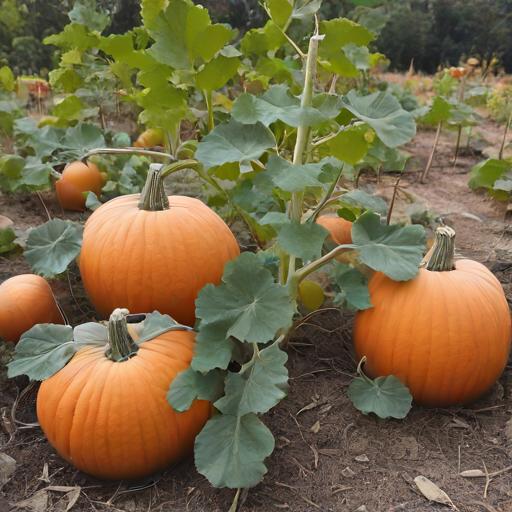- Hardiness Zone: 3-10 Annual
Seed Depth: 1–1.5 inches
Seed Spacing: 24–36 inches
Row Spacing: 6–8 feet
Sunlight: Full sun
Days to Sprout: 7–10 days
Days to Maturity: 90–100 days
Growth Habit: Sprawling vine
Sunlight: Choose a location that receives full sun for at least 6-8 hours a day. Pumpkins thrive in warm, sunny conditions.
Soil: Prefers well-drained, fertile soil with a pH between 6.0 and 7.5. Amend the soil with compost or well-rotted manure to enhance fertility and drainage. Pumpkins are heavy feeders, so nutrient-rich soil is essential for optimal growth.
When to Plant: Sugar Pie Pumpkins are warm-season crops that should be planted after the danger of frost has passed and the soil has warmed to at least 70°F (21°C). In cooler climates, you can start seeds indoors 3-4 weeks before the last frost date and transplant them outdoors after the soil has warmed.
Direct Sowing: Sow seeds directly in the garden 1 inch deep in hills spaced 4-6 feet apart. Plant 3-5 seeds per hill, and thin to the 2-3 strongest seedlings once they are a few inches tall.
Transplanting: If starting indoors, transplant seedlings outdoors when they have 2-3 true leaves and the soil has warmed.
Watering: Keep the soil consistently moist but not waterlogged. Water pumpkins regularly, especially during dry periods, to ensure even moisture. Water at the base of the plant to avoid wetting the foliage, which can lead to disease. Reduce watering slightly as the fruit begins to mature to enhance sweetness.
Fertilization: Pumpkins are heavy feeders. Apply a balanced fertilizer or compost at planting time. Side-dress with a nitrogen-rich fertilizer when the plants are about 6 inches tall, and switch to a phosphorus and potassium-rich fertilizer when the plants start to flower.
Mulching and Weeding: Apply a layer of mulch around the plants to retain soil moisture, suppress weeds, and keep the soil temperature consistent. Mulch also helps protect developing pumpkins from soil contact, which can cause rot. Hand-pull weeds carefully to avoid disturbing the shallow roots of the pumpkins.
Pruning: Trim excessive vines to focus energy on fruit development.
Training and Space Management: Sugar Pie Pumpkins are vining plants that require ample space to spread. If space is limited, consider using trellises to train the vines vertically, but ensure the trellis is sturdy and provide support for the developing pumpkins as they grow.
Pest and Disease Management: Pumpkins can be susceptible to pests such as squash bugs, cucumber beetles, and vine borers. Use organic pest control methods like neem oil, insecticidal soap, or hand-picking to manage infestations. Practice crop rotation and ensure good air circulation to prevent fungal diseases like powdery mildew.
When to Harvest: Sugar Pie Pumpkins are typically ready to harvest 90-100 days after planting. Harvest when the pumpkins have turned a deep orange color, the skin is hard, and the vines begin to die back. The stem should also be firm and dry.
How to Harvest: Use a sharp knife or pruning shears to cut the pumpkin from the vine, leaving a few inches of stem attached. Handle the pumpkins gently to avoid bruising, and cure them in a warm, dry place for about a week to toughen the skin and enhance storage life.
Storing Fresh Pumpkins: After curing, store Sugar Pie Pumpkins in a cool, dry place with good air circulation. They can be stored for up to 3-4 months. Check them regularly for signs of rot or soft spots and use any damaged pumpkins immediately.
Why You’ll Love It
Sugar Pie Pumpkins are the classic heirloom choice for rich, sweet pumpkin flavor in all your favorite fall recipes. These compact, productive vines produce 6–8 inch fruits with smooth orange skin and dense, fine-textured flesh. Unlike ornamental pumpkins, this variety was bred for baking and flavor. They store well and are perfect for gardeners looking to grow their own holiday pies, soups, and seasonal treats.
Plant Characteristics
Height: Low-growing vine
Growth Habit: Spreading vines up to 6–8 feet
Fruit Type: Round, bright orange pumpkins, 6–8 inches, 4–6 pounds
Days to Maturity: 90–100 days
Hardiness: Warm-season annual
Flavor and Culinary Uses
Flavor: Sweet, smooth, and dense with fine-grained texture
Culinary Uses: Perfect for homemade pies, purées, soups, roasted dishes, and baked goods. Keeps well in cool storage for winter use.
Companion Planting Tips
Good Companions: Corn, beans, nasturtiums, marigolds, and radishes
Avoid Planting Near: Potatoes, which compete for nutrients and space
Bonus Benefit: Large pumpkin leaves shade out weeds and help retain soil moisture in summer heat
Common Issues and Solutions
Poor Pollination: Attract bees by planting flowers nearby or hand-pollinate in early morning
Powdery Mildew: Provide good air circulation and avoid overhead watering
Fruit Rot: Use mulch or straw to lift pumpkins off damp soil as they mature
Seeds Per Packet
| 5g | Approximately 45 |
| 10g | Approximately 90 |
| 15g | Approximately 135 |
| 20g | Approximately 180 |
Why You’ll Love It
Sugar Pie Pumpkins are the classic heirloom choice for rich, sweet pumpkin flavor in all your favorite fall recipes. These compact, productive vines produce 6–8 inch fruits with smooth orange skin and dense, fine-textured flesh. Unlike ornamental pumpkins, this variety was bred for baking and flavor. They store well and are perfect for gardeners looking to grow their own holiday pies, soups, and seasonal treats.
Plant Characteristics
Height: Low-growing vine
Growth Habit: Spreading vines up to 6–8 feet
Fruit Type: Round, bright orange pumpkins, 6–8 inches, 4–6 pounds
Days to Maturity: 90–100 days
Hardiness: Warm-season annual
Flavor and Culinary Uses
Flavor: Sweet, smooth, and dense with fine-grained texture
Culinary Uses: Perfect for homemade pies, purées, soups, roasted dishes, and baked goods. Keeps well in cool storage for winter use.
Companion Planting Tips
Good Companions: Corn, beans, nasturtiums, marigolds, and radishes
Avoid Planting Near: Potatoes, which compete for nutrients and space
Bonus Benefit: Large pumpkin leaves shade out weeds and help retain soil moisture in summer heat
Common Issues and Solutions
Poor Pollination: Attract bees by planting flowers nearby or hand-pollinate in early morning
Powdery Mildew: Provide good air circulation and avoid overhead watering
Fruit Rot: Use mulch or straw to lift pumpkins off damp soil as they mature
Seeds Per Packet
| 5g | Approximately 45 |
| 10g | Approximately 90 |
| 15g | Approximately 135 |
| 20g | Approximately 180 |







Share and get 15% off!
Simply share this product on one of the following social networks and you will unlock 15% off!